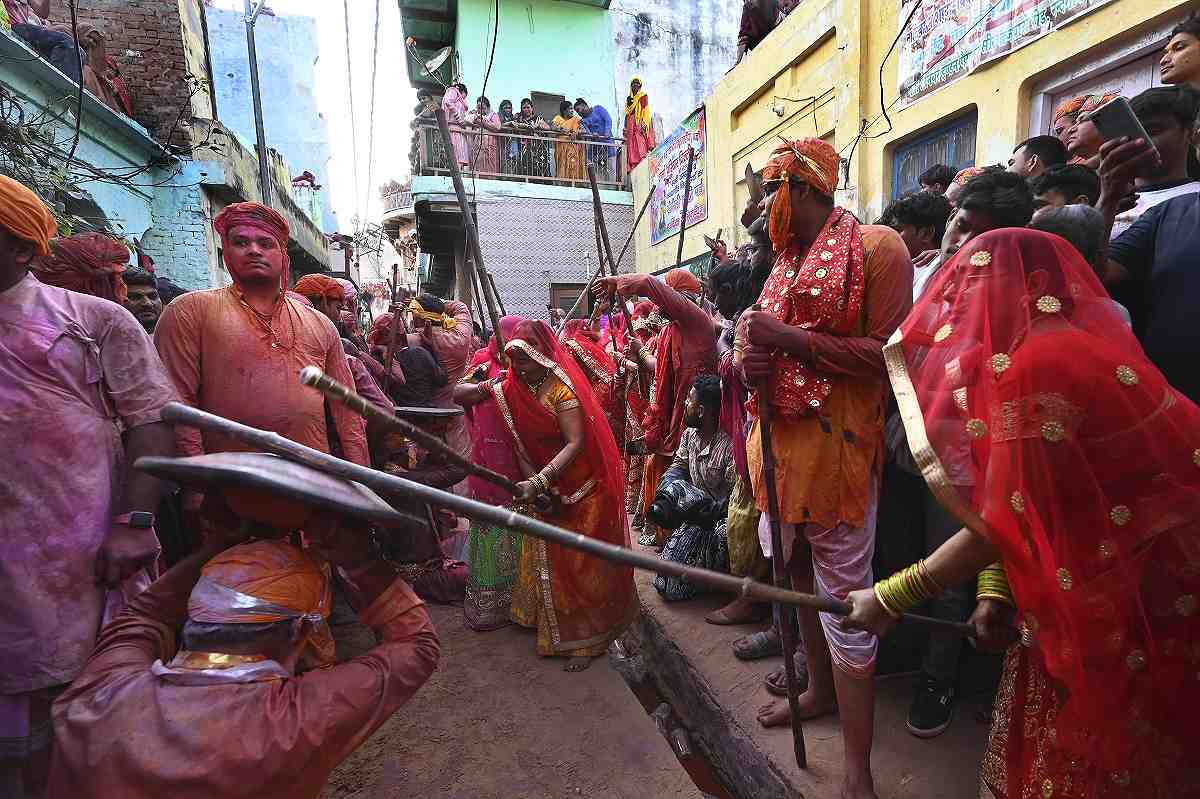
Women perform Lathmar Holi with men from Barsana village in Nandgoan village, 115 kilometers south of New Delhi, on March 1.
15:51 JST, March 16, 2023
NANDGAON, India (AP) — Hundreds of women in two north Indian towns celebrated Holi, the Hindu festival of colors, by playfully hitting men with wooden sticks in response to their teasing as part of a ritual.
After two years of subdued revelry due to COVID-19, the Holi celebrations recreated the legend of the Hindu god Krishna spraying his consort Radha and her friends with red, yellow, green and saffron colors. The women were from Nandgaon, the hometown of Krishna, and the men were from Barsana, the legendary hometown of Radha.
The men wore turbans and held shields above their heads to protect themselves from the women’s hits in the mock battle.
The devotees, smeared in colored powder, then prayed at the Nandagram Temple near where Hindus believe Krishna and his brother Balram spent their childhood. The temple was built at the beginning of the 19th century.
They exchanged sweets and drinks as part of the celebrations.
Some men were caught by women and made to dress like them. They then sang and danced along with the women.
The “Lathmar Holi” (Stick Holi) festival attracts visitors from around the world in large numbers to experience the celebrations, which are a symbol of India’s cultural heritage. The twin towns of Nandgaon and Barsana are about 115 kilometers south of New Delhi.
Holi, which marks the advent of spring, is widely celebrated in India, Nepal and other countries with large Indian subcontinent diaspora populations.
"World" POPULAR ARTICLE
-

8 Japanese Nationals Stranded on Indonesia’s Sumatra Island
-

Mozambican Cooking Class Held in Matsuyama, Ehime Pref.; Participants Don Aprons, Bandanas Made from Traditional Mozambique Fabric
-

China to Impose Sanctions on Shigeru Iwasaki, Former Head of Japan’s Self-Defense Forces, Who Serves as Adviser to Taiwan’s Executive Branch
-

China Steps Up ‘Wolf Warrior’ Diplomacy Against Japan, Hurling Accusation About Plutonium Stockpile
-

U.S. Senate Resolution Backs Japan, Condemns China’s Pressure
JN ACCESS RANKING
-

Keidanren Chairman Yoshinobu Tsutsui Visits Kashiwazaki-Kariwa Nuclear Power Plant; Inspects New Emergency Safety System
-

Imports of Rare Earths from China Facing Delays, May Be Caused by Deterioration of Japan-China Relations
-

University of Tokyo Professor Discusses Japanese Economic Security in Interview Ahead of Forum
-

Japan Pulls out of Vietnam Nuclear Project, Complicating Hanoi’s Power Plans
-

Govt Aims to Expand NISA Program Lineup, Abolish Age Restriction






















